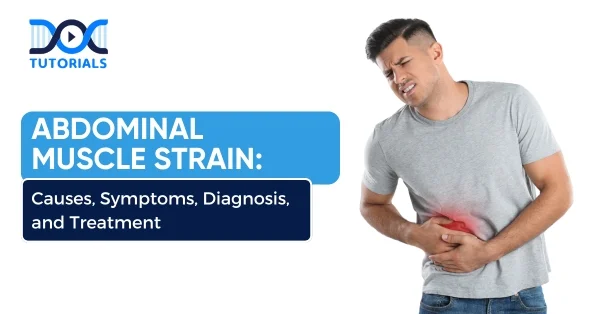Abdominal Muscle Strain: Causes, Symptoms, Diagnosis, and Treatment

Abdominal muscle strain refers to the overstretching or tearing of muscles on the abdominal wall caused by unexpected twisting, heavy lifting, or too many abdominal exercises. These core muscles, such as the rectus abdominis, obliques, and transversus abdominis, aid in stabilising the spine. However, they are also liable to be overworked.
This is a common condition in sports medicine and general practice, making it a high-yield clinical scenario in NEET PG and other medical entrance exams. Thus, it is essential to understand its causes, clinical features, and management, not only to pass exams but also to practice effectively.
Read on to have a thorough case analysis of the causes, symptoms, diagnosis, and treatment of abdominal muscle strain presented in a concise and exam-oriented way.
What is an Abdominal Muscle Strain?
Abdominal muscle strain involves a strain in the core muscles, resulting from excessive stretching or tearing, typically caused by overuse or acute stress. It is commonly referred to as a “tummy tear”, but technically, it is a pull of the muscles in the abdominal wall.
The abdomen is home to important muscles, such as the rectus abdominis, obliques, and transversus abdominis, which maintain the back, trunk, and spine. They can be injured, hurt, and weaken the core as they are overloaded. These muscles complement each other, as they help flex and rotate the trunk while also guarding the organs.
You experience pain in the middle of your body when muscles are overstretched or torn (for example, due to a sudden twisting movement or heavy lifting). For instance, if your abs hurt sharply when you cough, sneeze, twist, or rise from a sitting position, it’s often a sign of an abdominal strain.
What are the Causes of Abdominal Muscle Strain?
The sudden or regular overloading of the core muscles is usually the cause of abdominal strains. The usual triggers are:
- Overuse in Sports or Exercise: The abs may become overstretched through regular twisting or bending (such as swinging a tennis racket, a golf swing, or a volleyball jump).
- Heavy Lifting or Awkward Motion: Stomach muscles can strain when you lift weights, shift furniture, or perform a sharp lifting movement with incorrect form.
- Trauma and Impact: Tears in the muscle fibres may occur due to a fall, a direct hit in the abdomen, or abrupt shock (e.g., in the event of a car accident).
- Violent Coughing or Sneezing: A vicious coughing or sneezing attack may repeatedly flex core muscles, inducing microscopic tears, particularly in cases of chronic cough.
- Excessive Abdominal Exercise: Doing sit-ups, crunches, or core exercises (particularly without a proper warm-up) too aggressively risks exerting too much force on already strained and weak abdominal muscles.
What are the Risk Factors of Abdominal Muscle Strain?
Athletes and generally active individuals who participate in sports involving rapid lateral motions (such as football, tennis, or baseball) have a higher risk. Acute increases in exercise severity or underpreparedness also increase the risk.
Such a person may be predisposed to strains due to the existence of a weak or imbalanced core, for example, if the right and left sides of the abdomen are not equally strong. On the whole, straining of the abs can occur in any person. However, some risk factors include lack of proper warm-ups, improper form, tiredness, and muscle overuse.
What are the Symptoms of Abdominal Muscle Strain?
Pain and tenderness in the midsection are the general characteristics of an abdominal strain. Typically, you feel stomach muscle pain localised at the injury site. The pain is usually sudden or occurs at the point of injury and often worsens with movement. You may have:
- Pain that is sharp, achy, or throbbing in the abdominal muscles at rest and even more during activity.
- Pain is often caused by habitual activities such as coughing, sneezing, laughing, bending, or getting up from a chair. This is why many people report abdominal pain when they cough or twist after a strain.
- Core stiffness, tightness, or spasms that cause discomfort when bending or twisting.
- Bruising or swelling near the abdomen (particularly in a moderate-to-severe tear). In more severe cases, you may notice a bruise on your skin or a knot in your muscles.
- A difficulty or weakness with the use of your core muscles until healing takes place.
A strained muscle usually causes local pain without other systemic symptoms. A muscle strain, unless associated with other more serious causes, will not cause gastrointestinal problems (such as constipation or nausea).
How is Abdominal Muscle Strain Diagnosed?
A doctor typically diagnoses an abdominal strain through a combination of a patient’s history and a physical examination. They will enquire how it started hurting, press or examine for tenderness or weakness, and they may notice twisting movements.
Although imaging techniques can assist in diagnosing fractures or hernias, no laboratory test can confirm a strain. As an example, an X-ray or an MRI can be performed when a doctor suspects the existence of broken ribs, a spine injury, or a hernia. In a severe Grade III pull, one might even feel a space or tear in the hand when touching a muscle.
Your treatment and recovery plan will be based on the grade of the strain diagnosed by a healthcare provider. Here is a detailed overview:
| Grade | Severity | Description | Common Symptoms | Recovery Notes |
| Grade I | Mild | Small stretch or micro-tear of muscle fibres | Mild pain, minimal strength loss | Recovers quickly with rest and basic care |
| Grade II | Moderate | Partial tear of muscle or tendon | Noticeable pain, swelling, limited motion | May require physical therapy; recovery in weeks |
| Grade III | Severe | Complete tear of muscle or tendon | Intense pain, bruising, major weakness | May need imaging, prolonged rest, or surgery |
What are the Treatment Options for Abdominal Muscle Strain?
The majority of abdominal strains can be treated conservatively (without surgery) through rest and slow restoration. This simple method can be outlined by the so-called RICE principle (Rest, Ice, Compression, Elevation), modified to the core muscles.
- Rest and Protect: Stop the triggering activity and avoid heavy lifting until pain eases. Rest in positions that relieve pressure (like lying with knees bent).
- Ice and Heat: Apply ice packs to the injured area for 10–20 minutes at a time, several times a day, during the first 1–3 days. This helps reduce swelling and numb pain. After the initial 72 hours, switch to heat or alternate between ice and heat. A warm compress or heating pad can relax tight muscles and improve blood flow.
- Medication: Over-the-counter pain relievers, such as ibuprofen (NSAIDs) or acetaminophen, can help ease pain and inflammation. Use them as directed to help you move and stretch more comfortably.
- Supportive Care: Gentle stretching of the abdominal muscles (as tolerated) and light core exercises can begin once the acute pain has decreased. A physical therapist can show you safe exercises to maintain flexibility and gradually rebuild strength. In the meantime, wearing a mild abdominal binder or compression garment can support the muscles and reduce strain during activities.
- Gradual Return to Activity: As healing progresses, slowly reintroduce normal movements. After a few days, try walking or gentle yoga to help prevent stiffness. Before resuming intense workouts, always warm up thoroughly and listen to your body – stop if the pain returns.
- Medical Care (if needed): Most cases recover fully within weeks with home care. However, if the pain is severe, persistent, or suggests a major tear or hernia (such as a bulge or digestive symptoms), seek medical attention, as surgery may be necessary in rare cases.
Physical therapy aids recovery through guided stretching and core strengthening. In stubborn cases, dry needling or ultrasound therapy may help. Still, the key treatment is time—most mild strains heal in 1–2 weeks, moderate ones in a few weeks to months, and severe tears may take longer.
FAQs About Abdominal Muscle Strain
- What does a torn stomach muscle feel like?
A torn stomach muscle usually causes sharp, deep, or stabbing pain at the injury site. It may feel like a spasm or a tight knot and worsen with movement, such as standing, twisting, or lifting. Unlike cramps, it doesn’t affect digestion.
- How long does an abdominal muscle strain take to heal?
Mild strains heal in 1–2 weeks. Moderate ones may take 4–6 weeks, and severe tears can take several months. Recovery is faster with rest, ice, and proper rehab. Avoid rushing back to the activity.
- How to understand whether it is a pulled muscle or something more serious?
The pain related to a pulled muscle is localised, accompanied by swelling and soreness, which deteriorates upon movement. Meanwhile, a hernia can present with a visible bulge and digestive complications and will not resolve with rest. Consult a physician if the symptoms persist or are abnormal.
- When should I see a doctor for abdominal pain?
Seek medical help for abdominal pain if:
- Pain is severe or lasts over a week
- There’s a visible lump or muscle gap
- You feel weakness, numbness, or trouble moving
- Pain makes it hard to sit, walk, or breathe
Conclusion
Treatment of an abdominal muscle strain is normally easy after resting, taking care, and exercising with patience. The majority of the patients recover without any complications. It is always prudent to be assessed in case the pain is uncommon and ongoing. With early diagnosis, recovery can be achieved quickly, and more severe conditions can be prevented or mitigated.
Learning platforms, such as DocTutorials, can offer high-yield guidance to medical students revising for exams, like NEET PG, or practicing in the field, with in-depth coverage on most core topics, including forensic medicine and community health. Check out our NEET PG courses today!
Latest Blogs
-

NEET PG Exam 2025- Date, Pattern, Marking Scheme, Subject Wise Weightage, and Exam Mode
NEET PG Exam 2025 is the ultimate gateway for medical graduates aspiring to pursue postgraduate courses in medicine, including MD,…
-

INI CET Exam 2025: Your Roadmap to Success – Key Topics, Strategies, and Lessons from Last Year’s Papers
The INI CET exam is more than just a test; it’s a significant milestone for many medical students aiming to…
-

INI CET Exam Success: Previous Year Question Papers & Ultimate Guide – INI CET PYQ
One can feel overwhelmed while preparing for the INI CET (Institute of National Importance Combined Entrance Test). A vast syllabus,…




